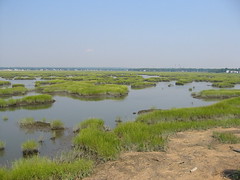Eco: Ice, sea and sand
We think of beaches as summer places, but a trip to the coast in winter promises its own rewards. I went with the boys to the Connecticut Audubon Coastal Center at Milford Point recently. We spent hours on the sandbar, chasing floating ice and poring over shells and old bits of horseshoe crabs.
After a cold wind forced us to retreat, we walked to the Center’s main building. Before going in, we climbed the tower at the corner to view two of Connecticut’s “critical habitats,” the tidal marsh to the west, and sandy beach to the east.

The Center is located between the beach of the Smith-Hubbell Wildlife Refuge and the tidal marsh of the Wheeler Wildlife Management Area, where the Housatonic River runs into the Long Island Sound, in Milford.
Shotgun blasts revealed hunters braving the cold in a small boat while (we imagined) they dreamed of duck for dinner. We headed inside, where the view through the bank of windows is nearly as spectacular, and where it is warm.
Tidal marshes are fragile places, where land and sea meet. On cold days it’s easy to imagine how they formed following the last Ice Age, and to see the threat that the homes, towers and stacks looming in the distance pose to their future.
During the ice advance of 20,000 years ago, the sea was lower and further out, some 70 miles south of Long Island. As the glacier retreated, water once locked in ice contributed to a rise in sea level that over thousands of years flooded the Atlantic coastal plain and “drowned” its river valleys.
Connecticut College Professor R. Scott Warren described how tidal marshes formed. “As the waters of Long Island Sound flooded coastal uplands they moved the shoreline inland, a process termed ‘marine transgression.’ Drowned coastal river valleys are our present day coves and tidal marshes.”
Grasses colonized coastal areas that filled with sediments. Plant remains accumulated as peat. Complex living communities arose, according to their elevation above the sea. Today, our marshes support a web of life—plankton, marine animals, birds, reptiles and mammals—in part due to tides that bring minerals and nutrients twice daily.
But, sea levels are on the rise again, at rates that now threaten to overwhelm our marshes. In the past, the marshes could move inland with the coastline. Today, there are buildings and highways in the way. As a result, tidal marshes are declining and in areas such as Greenwich, may soon disappear altogether.
0 Comments:
Post a Comment
<< Home